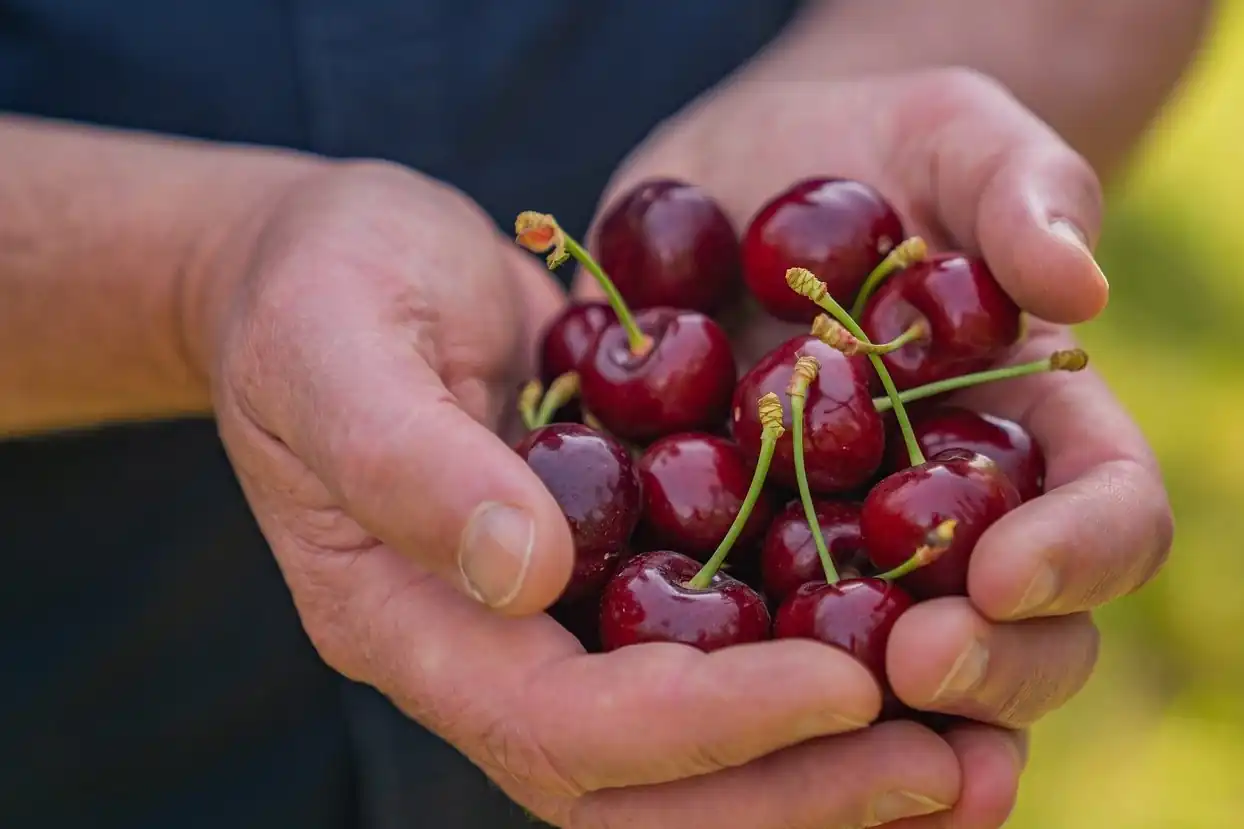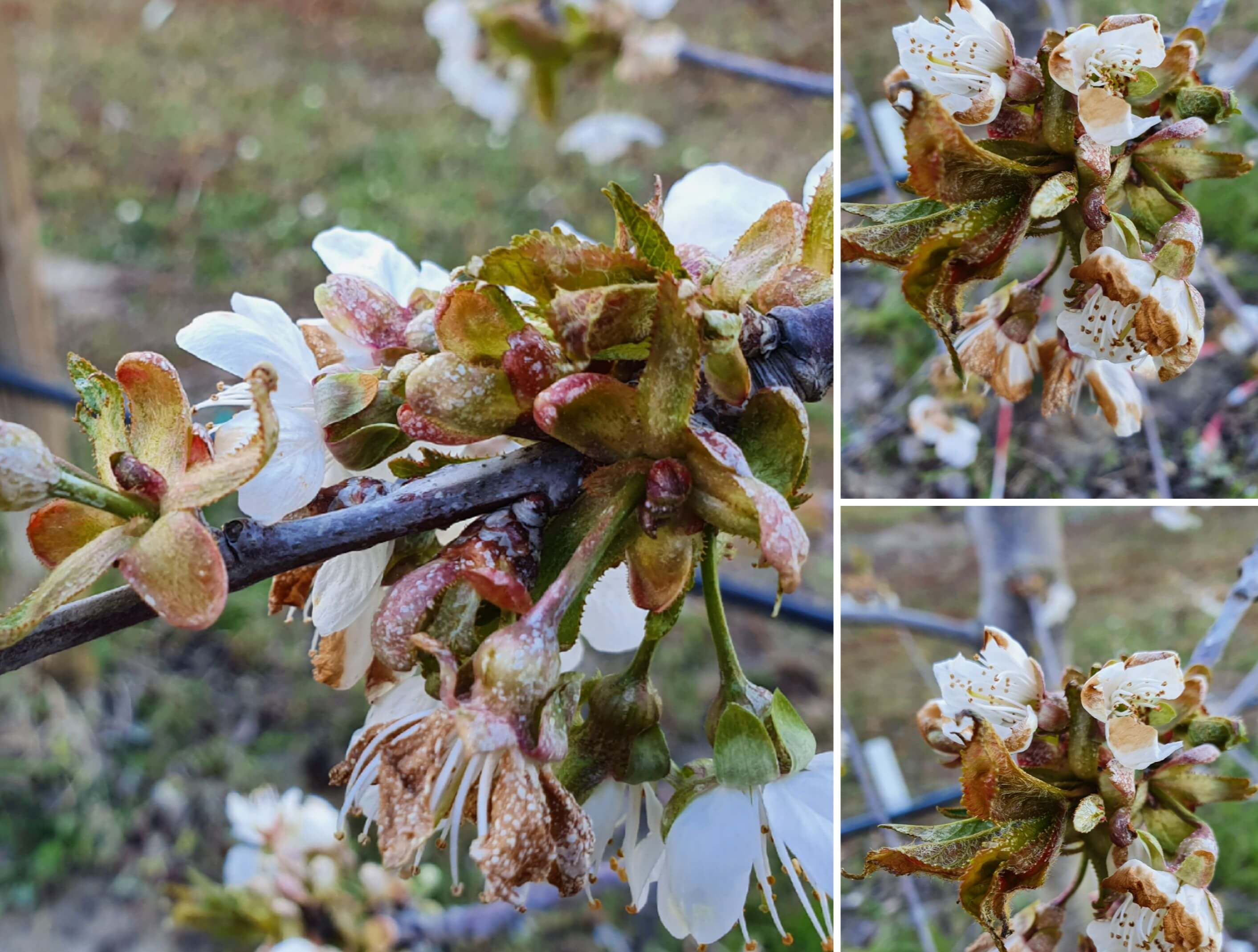The results of a study conducted by the Pontificia Universidad Católica de Chile provide valuable data on temperature, humidity, and solar radiation interception in cherry trees grown under macrotunnels and plastic-covered greenhouses, compared to open-air plants, both before and after harvest.
This information is crucial to influence plant phenology, protect it from abiotic stress, and manage irrigation properly, among other aspects.
For several years, the Pontificia Universidad Católica de Chile has been studying the impact and management of plastic covers in cherry production. Through various experiments, researchers monitored environmental and growth parameters in commercial orchards, generating microclimatic, physiological, and agronomic data on the use of this technology.
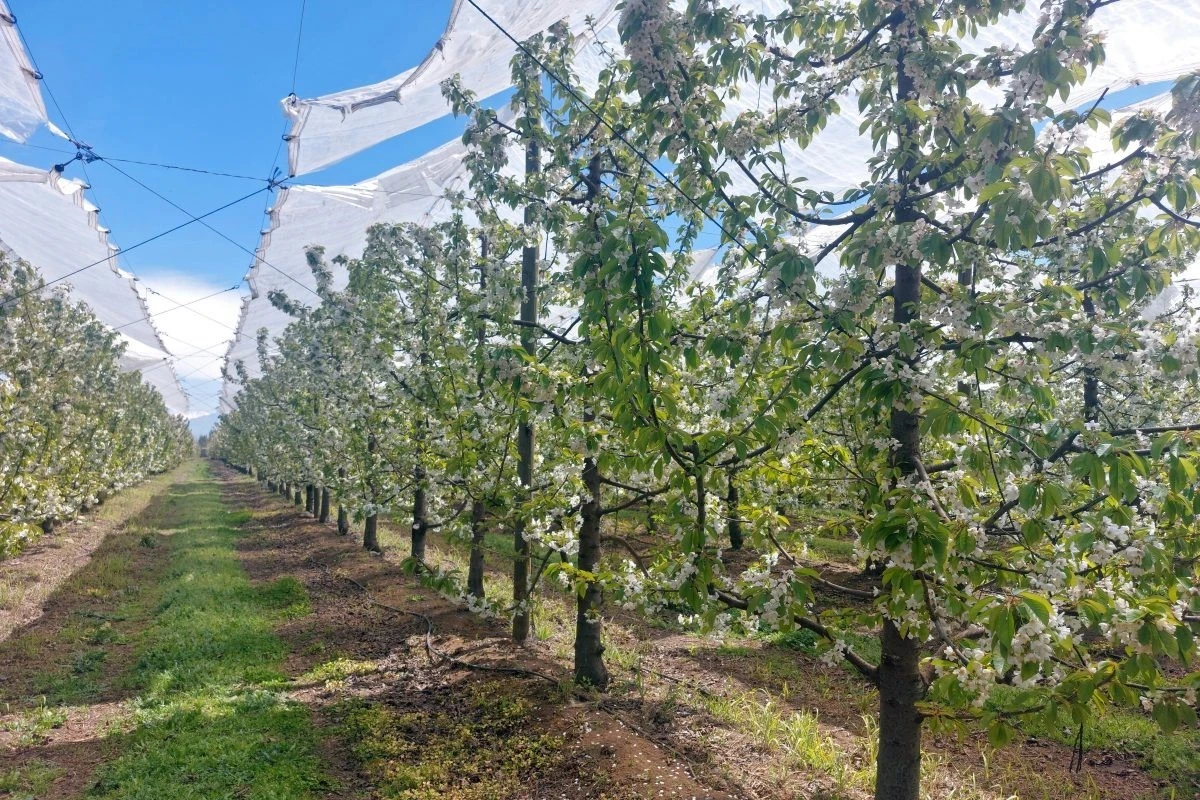 Image 1. Plastic covers can increase the initial accumulation of growing degree days.
Image 1. Plastic covers can increase the initial accumulation of growing degree days.
Effects of Plastic Covers
Initially, the research focused on the potential of plastic covers to protect fruits from rainwater and thereby prevent cracking.
In recent years, depending on the type of structure, additional benefits related to microclimate have been identified. These include the ability to increase the initial accumulation of heat, allowing earlier phenological development and cherry harvesting.
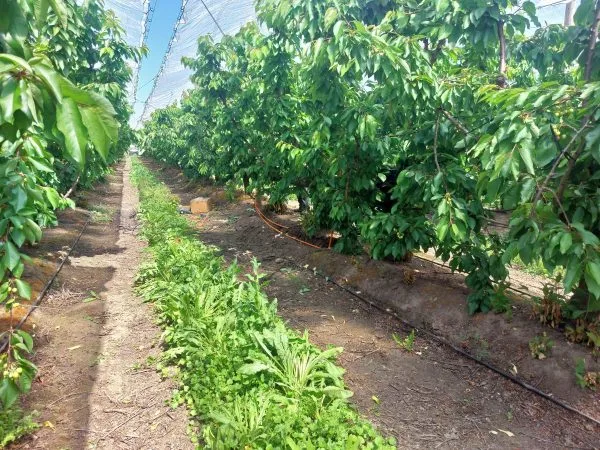 Image 2. Soil temperatures showed significant variations between treatments.
Image 2. Soil temperatures showed significant variations between treatments.
Moreover, in the case of frost events, a beneficial effect was observed in preventing sudden temperature drops of 1 or 2°C. It was also found that some structures create environments with lower water needs, thus reducing irrigation requirements.
A recent study analyzed various microclimatic parameters related to abiotic stress in cherry trees and tree behavior during spring and summer.
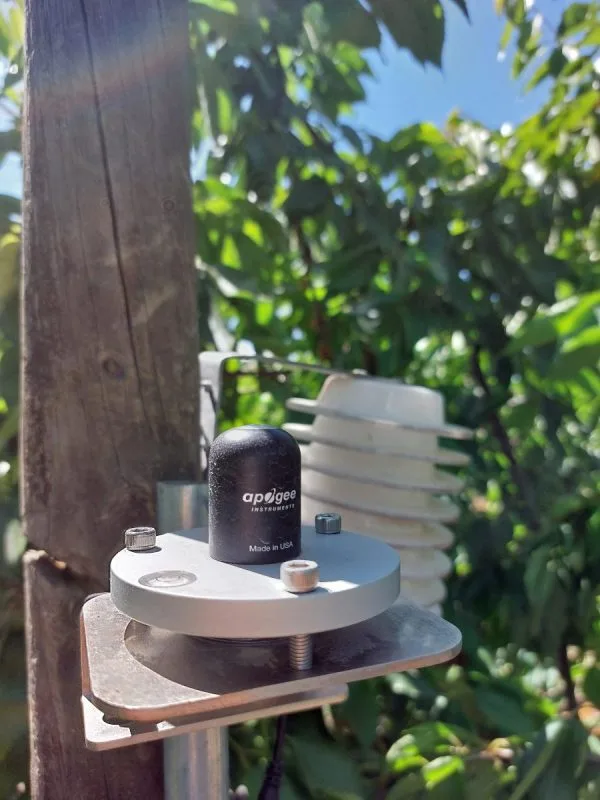 Image 3. Microclimatic parameters were monitored throughout the post-harvest spring-summer period.
Image 3. Microclimatic parameters were monitored throughout the post-harvest spring-summer period.
Microclimatic Study in the Maule Region
The study included measurements taken under a plastic cover tent (high-density polyethylene), under a macrotunnel (low-density polyethylene), and in open air, extended beyond the harvest period (until the end of December).
This allowed for a comparison of the effects of keeping covers extended for a longer period, precisely when environmental stress is highest (high temperatures, intense solar radiation, low atmospheric and soil humidity).
It is important to note that the aim of this article is not to recommend this practice to growers but rather to analyze the microenvironmental response in cases where covers remain in place even after fruit harvesting.
The tent cover was extended to prevent fruit cracking from October 26 to December 21, 2023. The macrotunnel remained open from September 1 to December 21, 2023.
Final Parameters and Measurements
Instead of removing the plastic covers as usual, they were kept extended.
The graphs below show some microclimatic parameters, both atmospheric and soil-based, recorded under both covers and in open air until December 21, 2023.
1. Ambient and Soil Temperature Behavior
a. Maximum Ambient Temperature
The maximum ambient temperature (T°max) under the macrotunnel was higher than in open air for the entire measurement period, with a significant difference at the beginning of the season.
For instance, on September 8, the T°max under the macrotunnel was 23.8°C, while in open air on the same day it was 19.4°C (Figure 1).
This rise in ambient temperature favored a greater accumulation of heat during the early season, advancing cherry tree phenology, particularly flowering and Stage I of fruit development.
After the tent cover was installed (October 26), T°max under it was similar to or even lower than that in open air. For example, on November 9: 29.6°C under the tent vs. 31.4°C in open air.
 Figure 1. Maximum ambient temperature in macrotunnel, tent, and open air in Molina, Maule Region, 2023.
Figure 1. Maximum ambient temperature in macrotunnel, tent, and open air in Molina, Maule Region, 2023.
b. Maximum and Minimum Soil Temperature at 40 cm Depth
Regarding the maximum soil temperature (T°max) at 40 cm depth (Figure 2), where the root system is concentrated, the macrotunnel showed slightly higher temperatures from September 1 to 22 (between 0.2 and 0.7°C), but higher T°max was later recorded in open air.
For example, on October 17, the soil T°max under the macrotunnel was 16.8°C, compared to 18.0°C in open air.
 Figure 2. Maximum soil temperature at 40 cm depth in macrotunnel, tent, and open air in Molina, Maule Region, 2023.
Figure 2. Maximum soil temperature at 40 cm depth in macrotunnel, tent, and open air in Molina, Maule Region, 2023.
After the tent was deployed, it more significantly reduced soil T°max, with differences of up to 4.1°C compared to open air, especially towards the end of the season.
On December 21, for example, soil T°max was 20.8°C under the macrotunnel, 18.9°C under the tent, and 22.9°C in open air.
As for minimum soil temperature (T°min) at 40 cm (Figure 3), a similar trend to T°max was observed. Between September 1 and 22, T°min was higher under the macrotunnel.
Later, T°min under the macrotunnel and in open air remained similar until early October, when open-air values started exceeding those under the tunnel. This difference persisted through the end of the measurements.
The tent showed the lowest T°min, with differences of 0.4°C to 3.5°C compared to open air.
In summary, the tent showed the greatest reduction in both T°max and T°min, followed by the macrotunnel, and lastly open air.
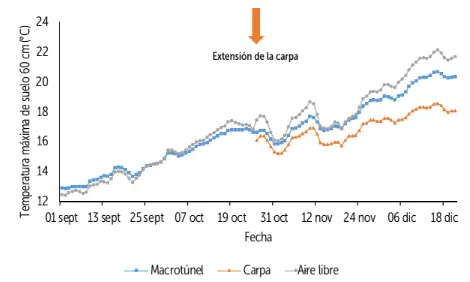 Figure 3. Minimum soil temperature at 40 cm depth in macrotunnel, tent, and open air in Molina, Maule Region, 2023.
Figure 3. Minimum soil temperature at 40 cm depth in macrotunnel, tent, and open air in Molina, Maule Region, 2023.
c. Maximum and Minimum Soil Temperature at 60 and 80 cm Depth
At 60 cm depth, both T°max and T°min were higher (by 0.2 to 0.5°C) under the macrotunnel until September 24. Afterwards, soil temperatures under the macrotunnel were lower than in open air throughout the evaluation period.
After the tent extension, the lowest T°max and T°min values were recorded under the tent, as also seen at 40 cm depth.
On December 21, for instance, T°max was 20.4°C under the macrotunnel, 18.1°C under the tent, and 21.7°C in open air (Figure 4).
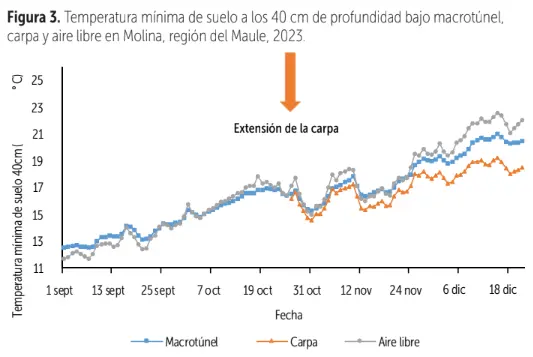 Figure 4. Maximum soil temperature at 60 cm depth in macrotunnel, tent, and open air in Molina, Maule Region, 2023.
Figure 4. Maximum soil temperature at 60 cm depth in macrotunnel, tent, and open air in Molina, Maule Region, 2023.
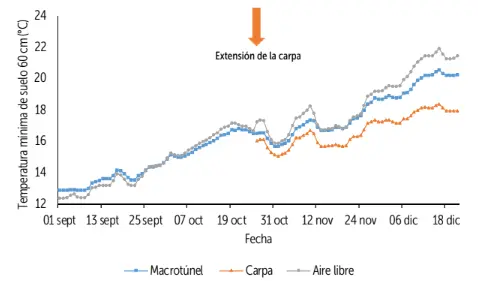 Figure 5. Minimum soil temperature at 60 cm depth in macrotunnel, tent, and open air in Molina, Maule Region, 2023.
Figure 5. Minimum soil temperature at 60 cm depth in macrotunnel, tent, and open air in Molina, Maule Region, 2023.
At 80 cm depth, T°max and T°min variations were smaller, especially under the plastic covers.
Table 1 shows the T°max and T°min values at different depths under the three treatments, for December 16.
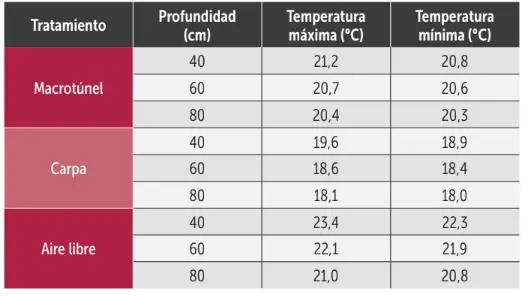 Table 1. Maximum and minimum soil temperatures at 40, 60, and 80 cm depth in macrotunnel, tent, and open air, on December 16, 2023.
Table 1. Maximum and minimum soil temperatures at 40, 60, and 80 cm depth in macrotunnel, tent, and open air, on December 16, 2023.
2. Maximum Photosynthetically Active Radiation
Plastic covers act as a physical barrier, thus reducing the interception of photosynthetically active radiation (PAR) that the plant can absorb.
This reduction depends on the type of plastic material (polyethylene) used for the cover. At the beginning of the season, before the tent cover was extended, the macrotunnel showed a PAR reduction ranging from 8% to 52% compared to open air.
After the tent was extended, a comparison of the three environments showed that the PAR reduction was highest under the tent, with values ranging from 37% to 85% compared to open air (Figure 6).
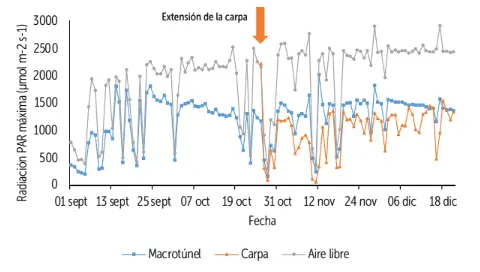 Figure 6. Maximum photosynthetically active radiation (PAR) in macrotunnel, tent, and open air in Molina, Maule Region, 2023.
Figure 6. Maximum photosynthetically active radiation (PAR) in macrotunnel, tent, and open air in Molina, Maule Region, 2023.
In fruit trees, it is estimated that around 1,000 μmol m⁻² s⁻¹ represents a saturation point for the photosynthetic process, leading to stomatal closure during periods of high radiation and temperature, resulting in reduced photosynthetic rates.
This implies that the use of certain covers could help mitigate the impact of abiotic stress (high radiation and temperature) during the most critical times of the day, provided PAR levels do not fall too far below 1,000 μmol m⁻² s⁻¹.
3. Volumetric Soil Water Content
At a depth of 60 cm, soil moisture remains more stable under plastic covers, while in open air it increases primarily following rainfall events.
After rainy periods, there is a significant loss of moisture that must be compensated with increased irrigation to meet the cherry tree’s needs (Figure 7).
Previous studies, conducted in collaboration with Dr. Víctor Blanco, have shown that proper management of plastic covers can reduce environmental water demand, as direct solar radiation and wind speed are lower under these covers compared to open-air conditions.
Reducing the crop’s water requirements (evapotranspiration) allows growers to decrease the volume of water applied to trees (fewer irrigations), without compromising vegetative development, yield, or fruit quality.
Conclusions
Monitoring climatic variables is essential for the correct use of plastic covers and for making decisions aligned with the production goals of a cherry orchard.
One of these goals—often a source of uncertainty for growers—is the strategy for deploying and removing covers, whether tents or macrotunnels.
The optimal timing for deploying and then removing the plastic sheets is linked to protection from weather conditions (rain, frost, radiation) and the possibility of advancing the harvest.
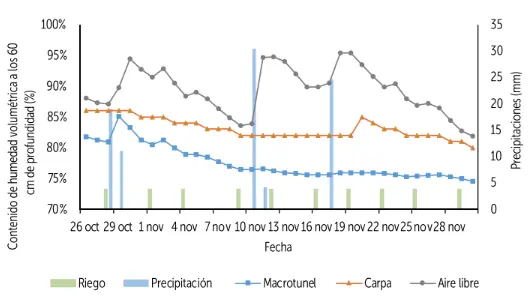 Figure 7. Evolution of soil moisture in macrotunnel, tent, and open air and irrigation volumes applied to cv. Santina, Maule Region, 2023.
Figure 7. Evolution of soil moisture in macrotunnel, tent, and open air and irrigation volumes applied to cv. Santina, Maule Region, 2023.
For this reason, it is essential to measure and understand the differences in air and soil temperature, air and soil humidity, and solar radiation interception, both before and after harvest, so that cherry growers can make timely and informed decisions.
This study, conducted in the Maule Region, analyzed the effect of plastic covers on orchard microclimate, keeping them extended even after harvest, with the goal of assessing their potential to protect trees from typical summer abiotic stress (December–January).
We are currently continuing evaluations to further refine post-harvest cover management strategies to mitigate abiotic stress.
Acknowledgments
We thank the entire team that made it possible to collect this information, including the partner companies involved in the project—Haygrove, Agrosystems, Inchalam, and oEnergy—and especially the Regional Government of Maule for supporting the FIC-R project initiative “Transfer of a prototype cherry cover system in Maule.”
Funding
Project funded by the Innovation and Competitiveness Fund (FIC) of the Regional Government of Maule.
Text and image source: Redagricola
Marlene Ayala, Maria Paz Quiroz, Victor Blanco, Renato Palomino, and Alonso Perez-Donoso
Pontificia Universidad Católica de Chile
Cherry Times – All rights reserved
















